How the new paradigm emerged
Fig.1
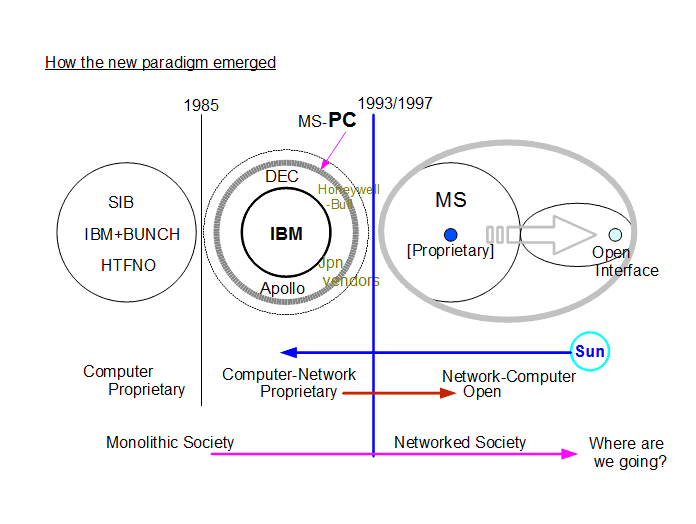
Sun was vision driven and faded away when the vision had been accomplished.
This presentation is about the paradigm shift of the society. The world still doesn't see where it is heading, and this presentation is made in an effort to explore what awaits us in the future.
D Engelbart did everything he's done such as invention of computer mouse with the vision looking backwards from philosophical and future space. His ABC model and the Augmentation system concept plays a significant part in this presentation in an attempt to picture how our society will shape in the future and how we go there.
Difference between Engineering system and People system:
Fig.2

This page is to clarify the difference between Engineering System and People System like organizational system.
The boundary for the People's System is loose and the system members contribute to building the boundary. This means that the boundary specifications are a result of the people's input and consciousness and not dependent on higher management.
Before Net: Discrete system
- People to integrate the 'system' by connecting information-
Fig.3
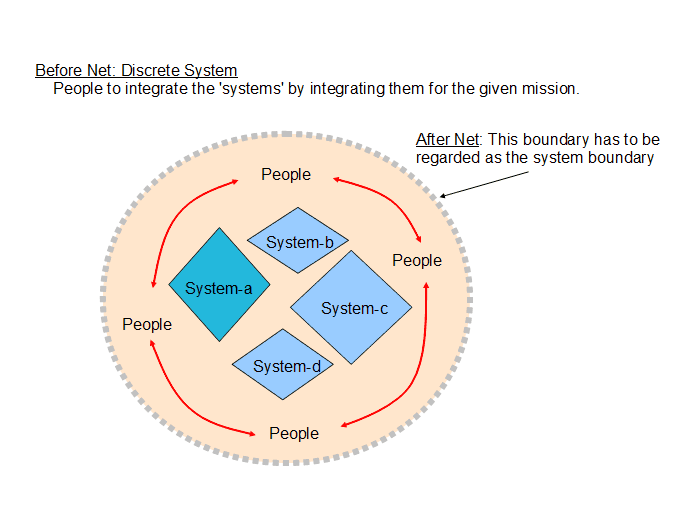
Before Net, when we say 'system', we meant engineering/computer/information system. People were not regarded as part of the 'system.' People were sitting around the 'system' and communicated through meetings, distribution of documents, telephones, and so on using the information they get from the 'systems' to perform necessary functions.
After Net, people are tightly connected real time, and it became necessary to expand the concept of the 'system' to include people in it. In doing so, we need to introduce a new concept such as Frame for actions because the system boundary will be defined by people's mindsets instead of engineering specifications.
After Net organization
Fig.4
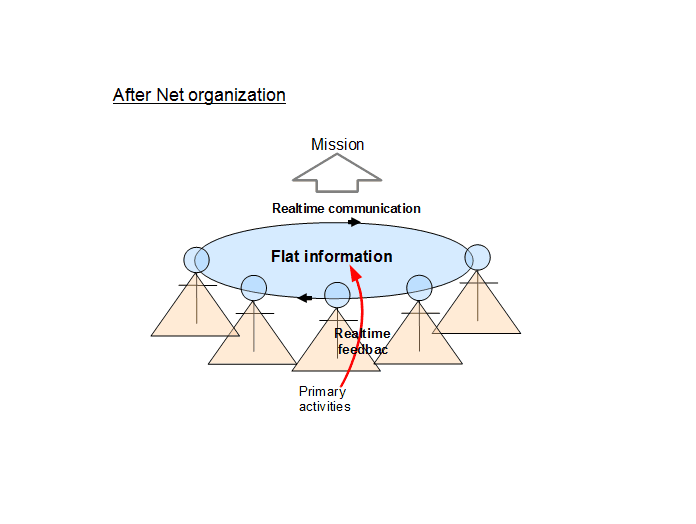
Current network infrastructure and IT technology enables people to share information across organizational borders in real time. An organization needs to create information-flat system internally, and people in the organization will have to work towards their missions rather than towards rules and orders given by the organization in order to cope with significant and changing demands in a networked society. This is where needs for People System come in.
Frame as the boundary for human action system
Fig.5
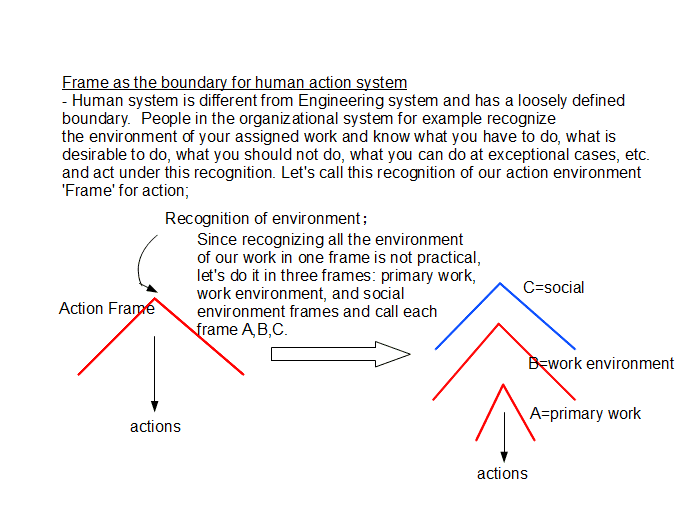
Once we introduce the concept of 'frame' for action, the next issue is how far do we need to go to recognize our environment which surrounds our primary activities.
'Portal' technology reverses the information flow
Fig.6
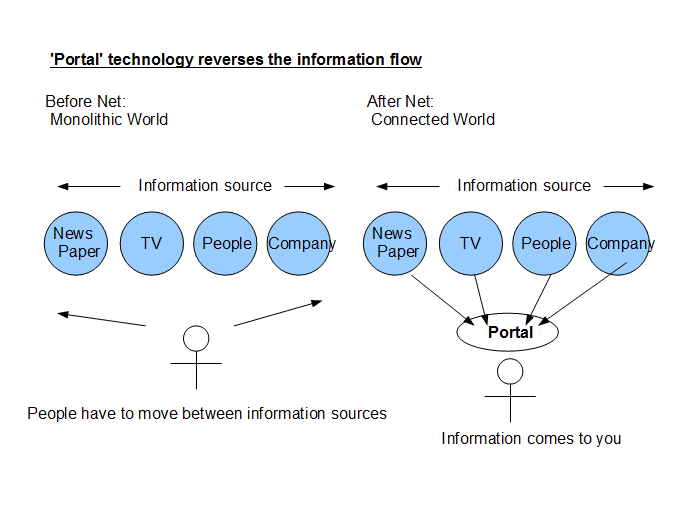
Before Net, people had to go to the information sources to get the information needed.
After Net, you can get information as needed in front of your terminal. They come to you.
With this, you come to expect even organizational service is done as one stop service; You just contact the call center of a company for your needs and get the service you want there, for example.
Internally to the organization, this is a big change in communication and information sharing; Lot of horizontal communication has to happen as needed vs traditional vertical /hierarchical communication.
Net-world demands Collaboration
Fig.7
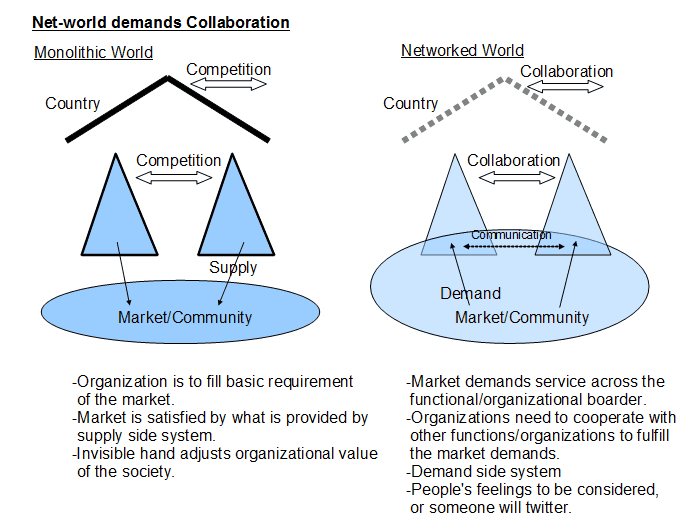
Where is the consciousness of people regarding the organizational system before and after the Net?
Before Net, people had a clear boundary image of an organization, and people knew what to expect from the organization (left chart). Organizations were structured with supply (organizational) side efficiency which resulted in hierarchical system.
After Net, market/community has begun to ask for one stop service, and when they are not satisfied, they can complain through network tools such as twitter. Business people somehow need to communicate with others in different functional groups and satisfy customers in order to avoid a flood of twitting which can cause considerable damage to a business. To do so smoothly, we need to look at it from one layer up and beyond our own functional frame (right chart).
We need to be aware that we are faced with people's feelings rather than just bodies in a networked society because frustrations and dissatisfactions come from feelings.
Mind structure in our work
Fig.8
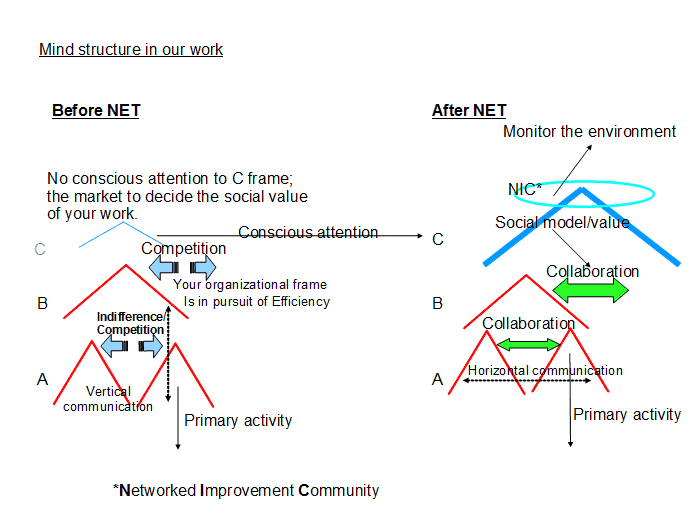
A company can not survive without adding value to the society.
When industry was primitive and market requirements were simple, profitability of a company was sufficient evidence that the company is adding value to the society.
When supply system reaches its maturity and the society begins to ask for added values like natural environment protection, then people in the organization need to become conscious about the value of their work in the market and the society. In order to do that, they need to have a frame model that defines their social environment they are in and set the mission of the organization properly so that it adds value to it.
In the chart, A is a functional frame of your primary work, and B is an organizational frame where you belong.
Before Net, if you do well at A and B, it was considered satisfactory.
After Net, doing well at A and B is not enough, and you now need to introduce C frame to consciously give social meaning to your work at A and B.
Nature/Body/Mind/ Conscious Frames and Activities
Fig.9

The right side of this chart is what we discussed in the previous chart and the ABC frame structure is recursively applied to personal, community, organizational, country level, etc. If B Frame is applied to country level, then C Frame becomes the world level. Then, who is observing the whole picture of this ABC Frames? It is us, the people. Then the issue is how ourselves are structured?
The left side of this chart is an attempt to organize our internal self, the relationship between our body and mind. When mankind were in absence of mind and the ABC frames etc. and still like animals, primary activities were conducted directly from the body. They lived just like animals and eat to live but not to eat more than they need to survive, which resulted in protecting and sustaining the ecosystem.
The left side of this chart, body-mind space is more mental/spiritual / religious /philosophical space. When people were economically poor, people kept this space rich by cooperating with others to live in harmony. The right side ABC frame is in a way economical space. In the past, this space was to make people not worry about the fundamental requirements of living but with the economical expansion, people's priority shifted to the right side space at the sacrifice of Body-Mental space. But once people are rich enough economically, we are in need to recover the richness of the body-mind space by our conscious efforts to make us feel more fundamental meaning in our primary activities toward our lives beyond the economical value.
Paradigm change of conscious work space:
-from Mono to Biaxial center society
Fig.10
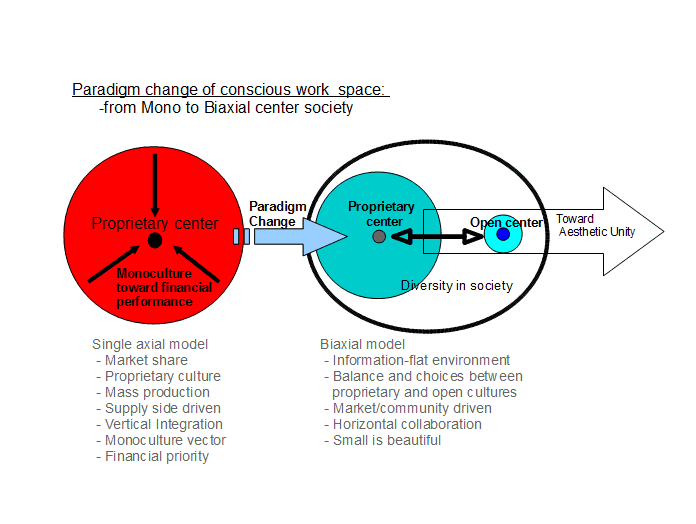
In the past, work space was a Mono center space seeking material/financial richness and production efficiency which led to bigger the better culture.
With an economical expansion, people's priority shifted to the right side space in previous page at the sacrifice of Body-Mind space. However, once our hungers for material and financial gain are satisfied, we need to recover the richness of the body-mind space consciously in order for us to feeling for the meaning of our life once again.
The world economical frontier now needs to recognize that people are a part of the nature and that we will have to put our economical space under the control of the body-mind space. In order to accomplish this, we will have to shift our economical system from Mono to Biaxial model and connect it seamlessly to the body-mind space. Gregory Bateson suggests Aesthetic Unity as the frontier spirit.
My favorite spirit at the Open-Center
My favorite spirit at the Open-Center
The first step is to switch from a prescriptive logic to a proscriptive one, that is, from the idea that what is not allowed is forbidden to the idea that what is not forbidden is allowed.
--The Embodied Mind by Francisco J. Varela, et al. pp195
To me, the beauty and significance of the Net is that it is, by its very design, a decentralizing force. Not only does it defy being controlled by any one entity, it doesn't discriminate.
-- Bill Joy Fortune Dec 11,'95
Humans' Capabilities Depend Upon their Argument System
Fig.12
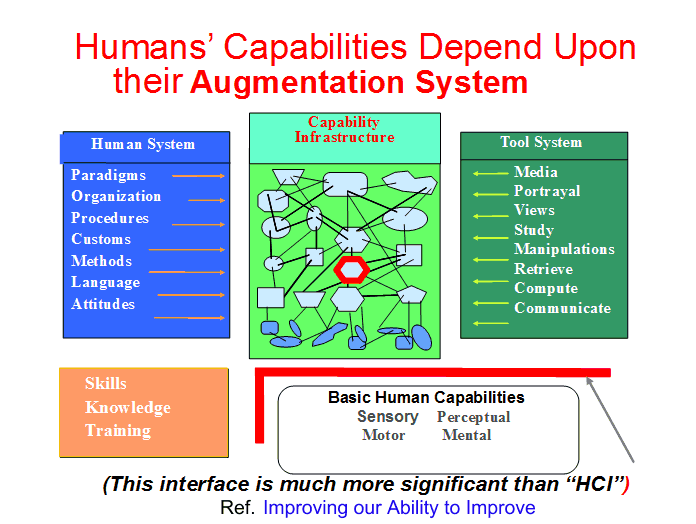
This is the most important chart for me from Douglas Engelbart for Aesthetic Unity. Although I still don't know how to explain this well, here it is just to give you a feel:
We live by the help of our surroundings which is the augmentation system. It consists of human elements and tool elements. Our personal capabilities need to be applied to connect functional parts using Human system and Tool system to perform given missions in our works, hopefully toward the Aesthetic Unity of the world. Also we need to accumulate the knowledge we gain as collective IQ dynamically as we go along and share it.
This Augmentation Model is valid over huge scale!
Fig.13
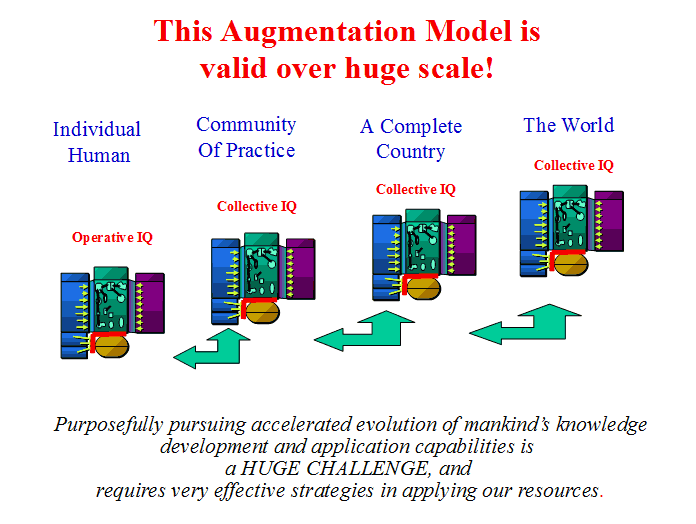
We live within various functional levels in the augmentation system, world, country, organizational, community, personal, etc. This augmentation system should be recursively applied in any level and be combined toward the Aesthetic Unity.












